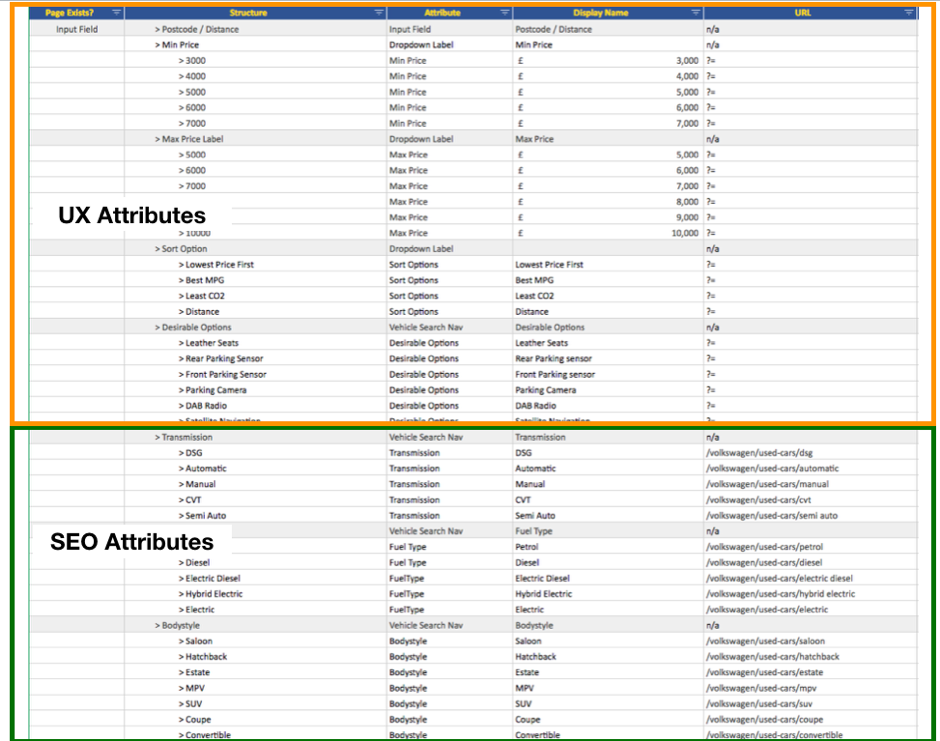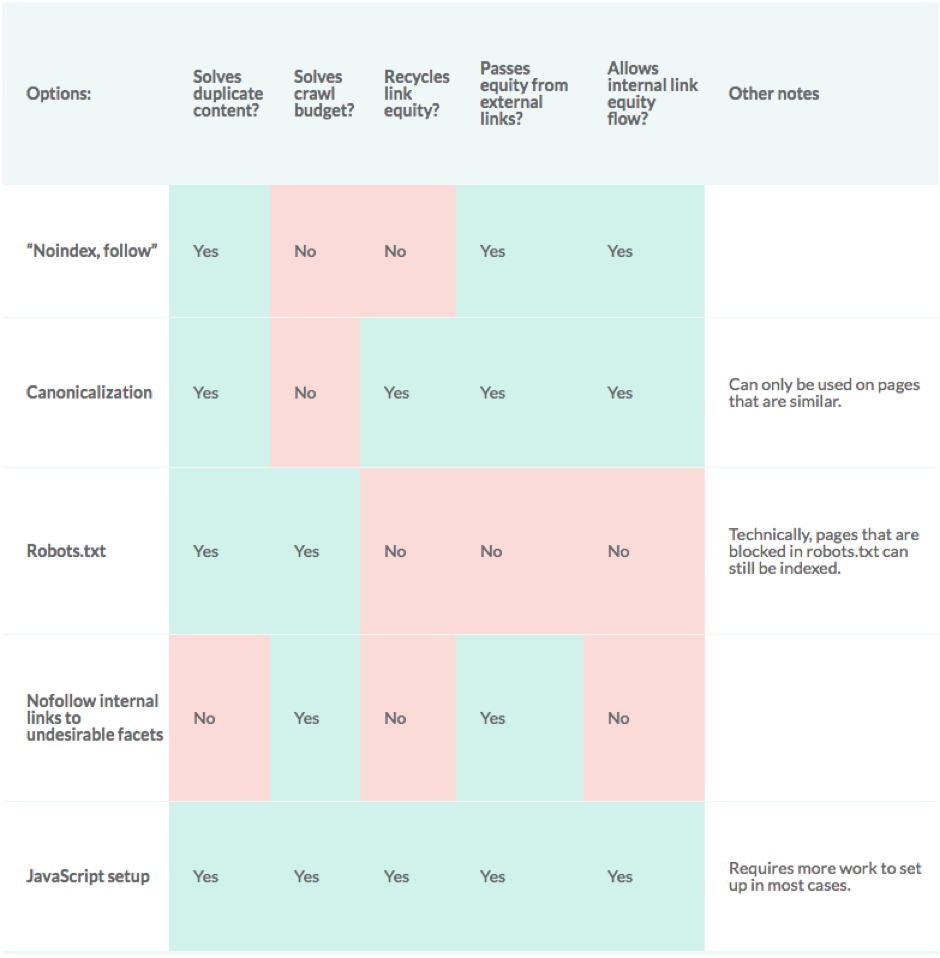3 min read
Honchō Scoops Up Two UK Search Awards!
It’s official, we've added not one, but two shiny trophies to our awards cabinet! We’re over the moon to share that we’ve triumphed at the UK Search...
With consumer trends changing rapidly and people now having the ability to easily browse 1000s of products, cars or listings from several different businesses, it’s become critical for a strong online presence.
Here I would like to explore the opportunity that lies ahead of us to increase keyword coverage and achieve a strong organic visibility through a faceted navigation.
Increasing your keyword coverage is pivotal to driving organic traffic and conversions to your site. The stronger your keyword coverage, the more likely users are to find your website in SERPS. Keyword coverage can be enhanced by creating new landing pages or re-optimising existing page targeting.
Faceted Navigation is classification system which allows the user to easily filter down to their results they’re after, once they’ve landed on your website. They’re typically used in e-commerce or listing websites such as car dealerships and jobs boards. Although they provide real value to the user’s experience, they’re often development led and negatively impacting SEO or your crawl budget.

When creating a vast amount of new landing pages, a faceted navigation allows you to make these pages accessible to search engines with internal links, without negatively impacting the website aesthetics or users experience.
By internally linking to new landing pages via a faceted navigation, nothing changes for the user, they see an intuitive navigation where they can arrange the products they want to browse. Behind the scenes though, there’s a lot of useful landing pages that have the ability to be found in Search Results (SERPS).
As navigations are often built around user experience they usually contain valuable filters/attributes such as colours, size, materials, brands etc, which people often search for. Using the filters you’re already serving pages for most of the search terms you want to target. Hence why it’s a great way to internally link to new pages.
Google’s mission statement is to organise the world’s data. This means that websites with well-organised content are rewarded with better ranking in Google’s organic listings. Organising your content within a structure also allows search engines to gather a greater understanding of how the website is structured which is often rewarded with better.
Duplicate content commonly occurs from ineffective URL facet ordering. This is when different URLs are created satisfying the same purpose. This often occurs when users take different routes through the navigation causing the same filters to create different URL variations.
For example:

Another common pitfall is returning pages with no products available. At IThinkMedia, we call this a “negative result”. Returning pages with no products negatively impacts the users experience and increases bounce rate. These pages should utilise a script removing the page from the navigation and implementing a temporary 302 redirect to the parent page.
Sometimes, you’ll find all filters return pages within your navigation that are indexable and can be crawled by search engines. Returning all filters as indexable and crawlable pages can greatly impact your crawl budget and transfer of link equity.
Within navigations, there are often filters such as price or the option to select a range e.g: Audi A1 up to 3 years old. These are low-value landing pages shouldn’t be crawled or indexed. They waste crawl budget and do not pass the equity back to the pages you want to rank.
Utilising a combination of competitor and keyword research, identify all of the attributes you want your navigation to support and how best to present them. This should include your UX attributes and also SEO (one’s people search for).
Through keyword research and a SERP analysis, you should identify the search terms you can rank for and have the ability to target off the back of your navigation filters. Pages should only be created where there’s a reasonable number of products, warrantable monthly search volume and search engines return websites similar to yours. These are the pages you want crawled regularly and served within SERPS.
On the other hand, you will have your UX attributes. These are attributes that serve a purpose for the user’s experience but provide no value for search as they target very low MSV search terms. These are the pages which often cause crawl budget and link equity issues.

“Do we care more about our crawl budget or our link equity?” By answering this question, we’re able to get closer to an ideal solution.
Arguably the first solution that would come to mind would be using a no index tag. It’s used to let crawlers know not to include a page in the index. It tells a bot to not index it, but the crawler still crawls the page. So essentially, it wastes crawl budget.
Combining the No Follow to all links to your UX filters and a No index will help save crawl budget. If you want, you could double up on this with a disallow in the robots.txt to be as convincing as possible. This should predominately be used when you want to save crawl budget and not transfer link equity.

Image source: Moz
To prevent duplicate URLs for pages that satisfy the same purpose, enforce a Strict URL facet ordering. This ensures that there’s only one variation of the page can be found.
Including breadcrumbs on each category and subcategory page helps crawlers and users navigate and understand your website. In addition to the navigational benefits, utilising breadcrumbs helps build relationships within the content and areas of the site so that crawlers have a greater understanding of the structure. For enhanced search engine understanding, utilise schema markup for breadcrumbs.
Increasing keyword coverage through a faceted navigation can be a detailed task, but with careful consideration, you can drive organic traffic in a way that maintains a fantastic user experience. Faceted navigation can greatly benefit a site, provided it is done correctly.
Get in touch to learn how we can help with your SEO strategy. Or, send us a Tweet at @iThinkMedia to let us know what you thought of this post on faceted navigation!

3 min read
It’s official, we've added not one, but two shiny trophies to our awards cabinet! We’re over the moon to share that we’ve triumphed at the UK Search...

5 min read
Understand ecommerce attribution models which attribution models can maximise your marketing efforts and ROI.

3 min read
Explore how social commerce is changing the way we shop online, blending social interactions with digital commerce for a seamless buying experience.